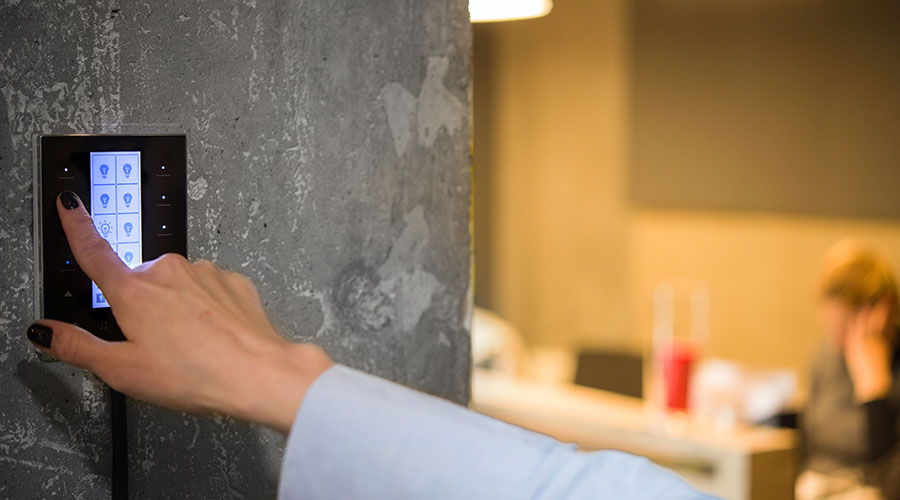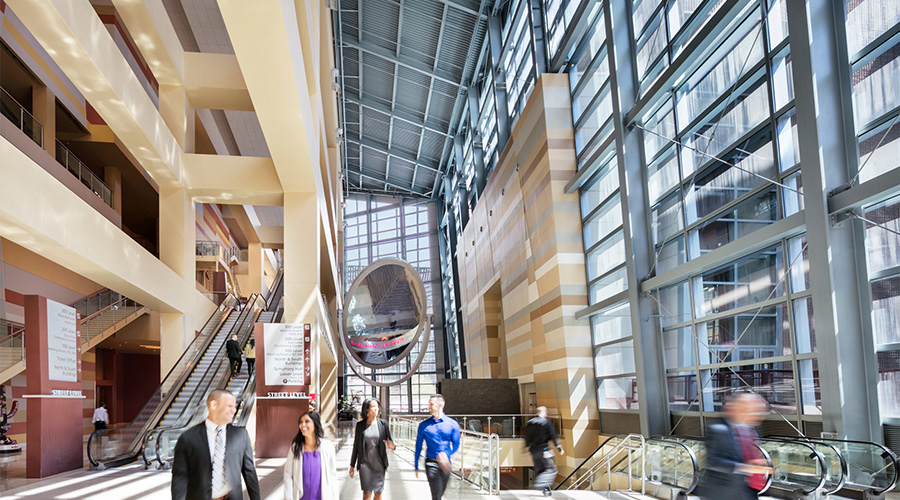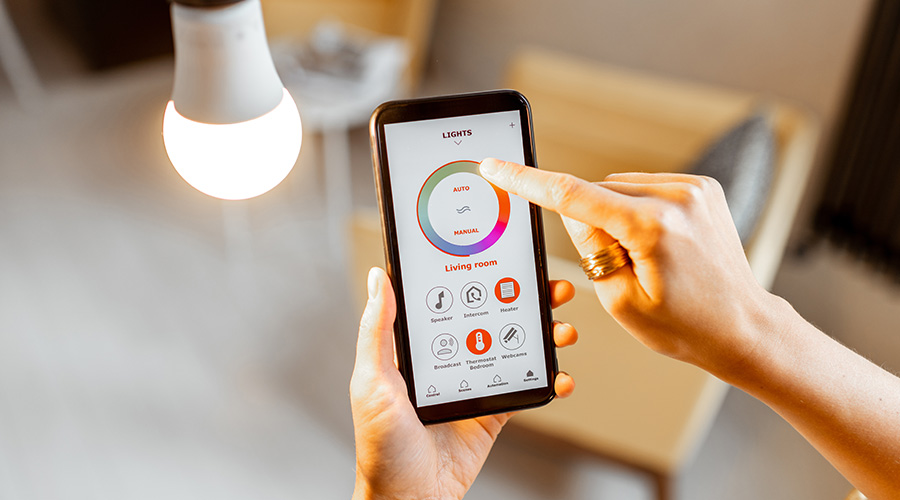Seattle Aquarium Weighs Lighting Needs of Aquatic Life and Staff
Seattle aquarium carefully considers the lighting needs of aquatic life, staff and visitors.
By Dave Lubach, Executive Editor
Maintenance and engineering managers involved in planning lighting projects at institutional and commercial facilities need to consider a number of factors beyond simply replacing existing lamps with longer-lasting, energy-saving LEDs.
While determining the proper light levels, installing control systems and taking advantage of natural light are critical aspects of effective lighting projects, the stakes are even higher in museums and aquariums, where preserving artifacts and protecting living organisms are an even higher priority.
When the Seattle Aquarium built a third atrium for its waterfront building, designers had to account for the marine life that would be housed inside, as well as the lighting needs of the employees and the thousands of visitors who walk through its doors.
Marine life considerations
The Seattle Aquarium Ocean Pavilion highlights the area’s connection to the Pacific Ocean. The 50,000-square-foot addition features living habitats, ecological experiences and hands-on opportunities to experience marine life.
The pavilion includes two large, public-facing habitats where visitors can observe the aquatic life, says Hanna Kato, a project architect for LWM, the firm that designed the building along with Thinc Design, who designed the exhibit spaces.
The first habitat is The Reef, a nearly 500,000-gallon, multi-story area designed to mirror an Indo-Pacific coral reef.
The second habitat consists of two smaller habitats – the Archipelago, an Indonesian mangrove forest that’s surrounded by a pool of sea stars fish and rays, as well as live plants, and another habitat that includes a variety of fish species and live coral.
“The lighting design needed to be extremely cognizant of both of these sensitive habitats,” Kato says. “For example, the team had to make sure there were enough lighting requirements for all of the plants, including grow lights.”
Just as designers need to consider user comfort in spaces such as classrooms or libraries, the pavilion design team took care to ensure the lighting systems in the habitats closely recreated sea conditions so the animals and vegetation can thrive.
“The animals are very sensitive to light, so the entire facility includes a lighting control system based on the animals’ circadian rhythm,” Kato says. “This means the front-of-house light output slowly increases over an approximately 90-minute timeframe. The duration that they stay at this level, and when the light output gradually decreases is all specifically planned with the Seattle Aquarium Ocean Pavilion aquarists.”
Coral systems also received special considerations from designers to replicate ocean conditions.
“Traditionally for coral systems, the lighting would be about 6 inches above the waterline to penetrate deep into the water,” Kato says. “However, for this viewing experience, that would be obtrusive to the exterior water. To address this, we worked with the lighting design team and Seattle Aquarium aquarists for the front-house design. This included custom fixtures over the coral habitat, which took extensive work to set in place and focus where needed to best recreate the natural habitat and simulate the ocean.”
Behind the scenes
Project designers for the expansion of the Seattle Aquarium Ocean Pavilion also needed to consider the space’s back-of-house lighting needs. When designing these areas, architects considered the duties of aquarium employees who work with the animals, as well as those responsible for the building systems and areas that guests can access.
“The aquarium and the exhibit designer collaboratively decided to incorporate behind-the-scenes (areas) as a component for the guest experience,” says Susan Bullerdick, the aquarium’s senior director of capital projects. “As such, the lighting ensures guests can safely navigate hallways and also allows them to clearly observe intricate details of the animal habitats and equipment.”
Aquarium planners and designers also experienced another element when addressing the back-of-house areas of the pavilion. Kato says a trend in aquariums is to give visitors unique, behind-the-scenes experiences at the way the facility cares for animals.
“With the guest path, you’ve gone behind the curtain, and you’re seeing the working side of the aquarium,” Kato says. “We really wanted to highlight that and let people see the working side. It’s a working operational machine, and there’s a lot of care and exactness that goes into the water quality, and taking care of the animals, and we think it’s really a beautiful piece of the story.
“All of the facility is like a fine-tuned machine, and we really wanted to show that to the public. It’s a really cool story for schools and kids to visit and realize there are job opportunities that they might not necessarily be aware of by exposing this kind of back-of-house relationship.”
Kenall Manufacturing, which provided the fixtures for the back-of-house lighting, faced a challenge during the aquarium expansion that facilities such as museums, entertainment centers and art galleries do not typically have to account for. Those facilities need to preserve artifacts when designing their lighting systems, aquariums need to focus on operating life-support systems 24 hours a day while maintaining water quality and protecting animals and marine vegetation.
“These harsh settings need chemical-resistant luminaires certified for wet locations to ensure that fixtures don’t fail while performing at optimum light output,” Bullerdick says. “High ingress protection ratings prevent the ingress of dust and water into the fixtures, reducing maintenance costs and time. These factors are crucial for ensuring worker safety, optimizing productivity and maintaining efficient operations.”
Designers ultimately opted for bright white illumination for the back-of-house areas to benefit employees responsible for food preparation, water quality monitoring, equipment maintenance and animal care.
“It reduces glare and harsh shadows, making it more comfortable for both the employees and guests,” Bullerdick says. “Being mindful of the animals meant that the lights could not be triggered by occupancy sensors.”
Humid conditions inside the aquarium’s new pavilion make the space a prime area for corrosion, so designers selected marine-grade luminaires. The luminaires are tested to withstand a 1,000-hour salt spray test, which convinced the facilities team the products could meet the challenges of the pavilion’s environment, Bullerdick says.
Aquarium officials sought LEED Gold and zero-carbon certifications during the expansion’s planning process, and the lighting systems play a significant role in achieving those goals.
“While the lighting design and selected systems all went through architects, working closely with them provided the opportunity to better understand the intricate relationship between lighting and the aquatic environment, and the importance of replicating the animals’ natural habitats,” says Jesse Phillips-Kress, vice president of facilities and operations for the pavilion. “This means carefully considering the intensity, duration and color spectrum of the light to match the depths and conditions of their origin.”
Dave Lubach is executive editor of the facility market. He has 10 years of experience writing about facility management and maintenance issues.
Related Topics:












